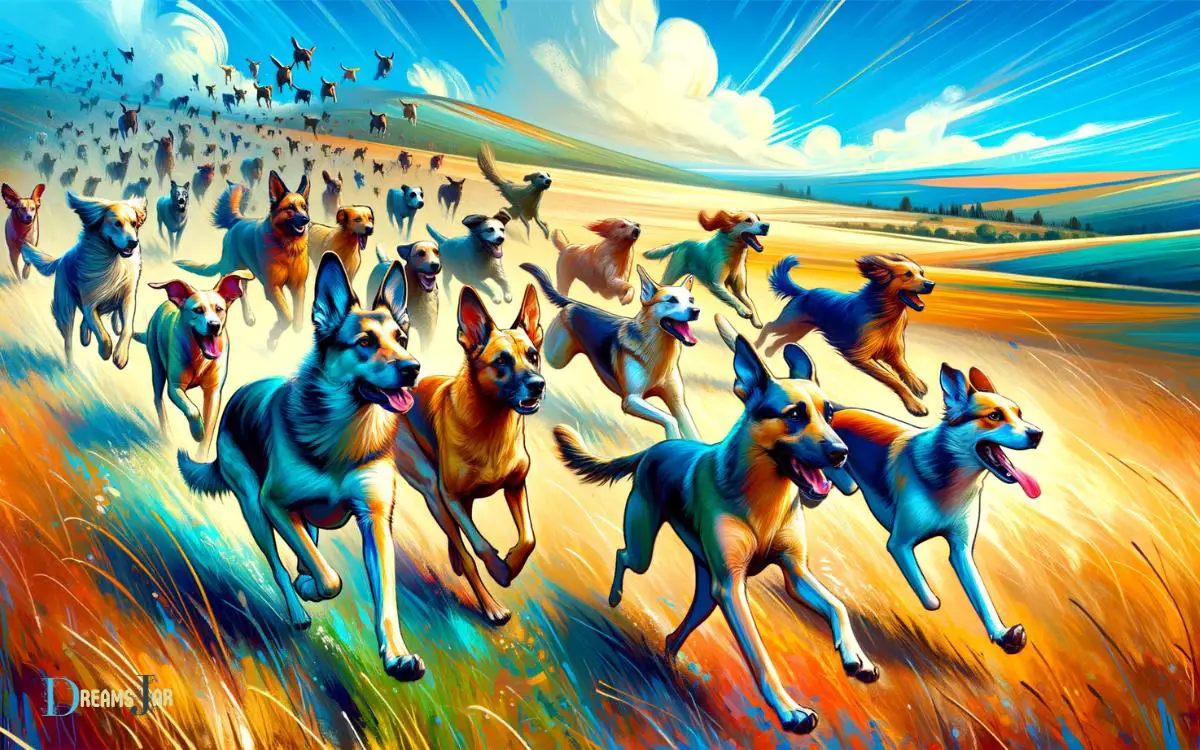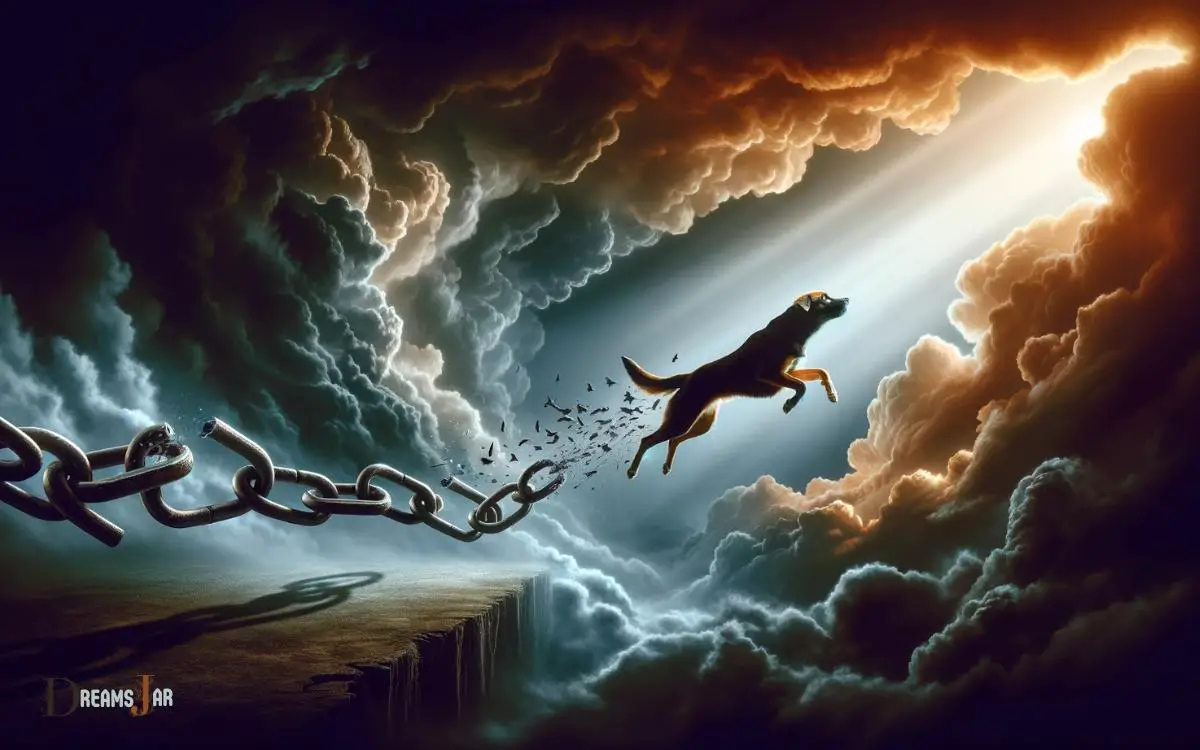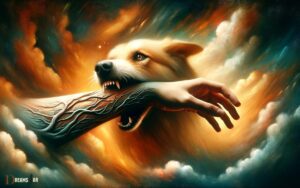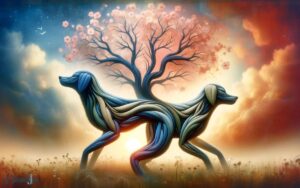Wild Dogs Running in a Slow Dream Meaning? Latent Emotions!
Dreaming about wild dogs running slowly can symbolize latent emotions, the need for patience, and understanding group dynamics.
These dreams often signify the presence of suppressed feelings or a situation that requires a calm and measured approach. It also may point towards your interaction within a group.
Dreams are a gateway into our subconscious mind. When you see wild dogs running slowly in your dream, it could be a representation of your suppressed emotions that are seeking an outlet.
For instance, the dogs can symbolize your feelings, while their slow pace may suggest that you are not expressing them fully or at the right pace.
Additionally, this dream can be a reminder for patience and balance. Just like the dogs are running slowly, it might be an indicator that you should take things slowly and not rush into decisions or actions.
In the vast landscape of dream interpretation, the image of wild dogs running slowly can hold various meanings.
It can be an echo of your inner emotions, a reminder for patience, or a reflection of your social interactions.

Key Takeaway
Symbol of Freedom and Independence
The symbol of freedom and independence is embodied by the wild dogs running in a slow dream.

- These majestic creatures represent the untamed spirit that resides within each of us, urging us to break free from societal constraints and embrace the wildness of our own existence.
- In their relentless pursuit of survival, wild dogs teach us the importance of self-reliance and adaptability.
- They roam the vast landscapes with unwavering confidence, reminding us that true freedom comes from within and cannot be granted or taken away.
- Their pack mentality demonstrates the power of unity and collective strength, emphasizing the significance of community and collaboration.
The wild dogs’ ability to navigate through the unknown territories of life with grace and determination serves as a powerful reminder that we too have the capacity to forge our own paths and live life on our own terms.
Unleashing Hidden Emotions and Desires
The sight of wild dogs running in a slow dream holds a profound symbolic meaning. It reflects the unleashing of hidden emotions and desires within our subconscious mind.
In the realm of dreams, these suppressed desires find an outlet for expression. This leads to a cathartic release of pent-up feelings.

Through this surreal experience, we are given an opportunity to confront and explore these buried emotions. It allows us to gain a deeper understanding of ourselves and our true desires.
Suppressed Desires Unleashed
Unleashed upon awakening, suppressed desires emerge with an intensity that cannot be ignored. These hidden emotions and desires, once confined to the depths of our subconscious, now break free, demanding our attention and exploration.
Like wild dogs finally released from their cages, they run rampant through the landscape of our psyche, leaving no stone unturned.
To better understand this phenomenon, let us delve into the symbolic nature of suppressed desires.
In the table below, we explore three common desires and their underlying meanings:
| Desire | Symbolism | Interpretation |
|---|---|---|
| Adventure | Freedom | A yearning for exploration and new experiences. It signifies a desire to break free from the constraints of routine and embrace the unknown. |
| Passion | Vitality | An intense longing for fulfillment and purpose. It represents a deep-seated need to engage in activities that ignite our passion and bring us alive. |
| Connection | Belonging | A longing for meaningful relationships and a sense of belonging. It reflects the innate human need for connection and the desire to be seen, heard, and understood. |
As these suppressed desires surface, it is crucial to acknowledge and honor them. By doing so, we can embark on a journey of self-discovery, personal growth, and fulfillment.
Emotional Catharsis Through Dreams
An essential aspect of emotional catharsis through dreams is the release and exploration of hidden emotions and desires.
- Dreams serve as a canvas where our subconscious mind paints vivid scenes, allowing us to tap into the depths of our psyche and uncover suppressed emotions and desires that may have been buried in our waking lives.
- In this state, our minds are free to wander and express the thoughts and feelings that we may not be consciously aware of.
- Dreams provide a safe space for us to confront and process these hidden aspects of ourselves, offering a therapeutic outlet for emotional release.
- Through dreams, we can gain valuable insights into our inner world, unraveling the complexities of our emotions and desires.
- This exploration of the subconscious can be a transformative journey, offering us the opportunity to heal, grow, and evolve.
- It is through these dreams that we can unlock the hidden chambers of our hearts and set ourselves on a path towards emotional liberation and self-discovery.
This emotional catharsis through dreams signifies a need for balance and patience in our waking lives.
Signifying a Need for Balance and Patience
A balanced and patient approach is indicated by the presence of wild dogs running in a slow dream.
This imagery serves as a symbolic reminder for individuals to embrace the qualities of balance and patience in their waking lives.

When wild dogs are observed running in a slow manner, it signifies the need for individuals to find equilibrium and exercise patience in various aspects of their lives.
This symbolism offers valuable insights into the importance of maintaining a steady and composed mindset in the face of challenges and obstacles.
To achieve balance and patience, consider the following:
- Cultivate self-awareness and self-control, allowing for a more measured response to situations.
- Practice mindfulness and grounding techniques to anchor oneself in the present moment.
- Seek support and guidance from others, fostering a sense of community and shared responsibility.
Exploring the Concept of Time and Perception
Time is a complex and elusive concept that is often subjective in nature. Our perception of time plays a significant role in how we experience and interpret events.
It is through our perception that time gains meaning and significance, shaping our understanding of the world around us.

Similarly, time has the power to influence our perception, altering our understanding and memory of past events.
Time’s Subjective Nature
With its subjective nature, the concept of time and perception can be explored through various lenses.
Time, as experienced by individuals, is not an objective entity but rather a deeply personal and subjective experience that varies from person to person.
- Time’s fluidity: Time can feel slow or fast depending on our state of mind and the activities we engage in.
- Time dilation: Our perception of time can be altered in intense or mundane situations, leading to distortions in our temporal experience.
- Temporal landmarks: Certain events or milestones can serve as anchors that shape our perception of time, giving us a sense of structure and meaning in our lives.
Perception’s Impact on Time
Continuing our exploration of the subjective nature of time, it is fascinating to consider how perception can significantly impact our experience of time, often resulting in distortions and variations in its passage.
- Time, in its essence, is a construct that is intimately intertwined with our consciousness. It is not an objective, external force, but rather a malleable entity shaped by our individual perspectives.
- Our perception of time is influenced by various factors, such as emotions, attention, and cognitive processes.
- When we are engaged in an enjoyable activity, time seems to fly by, while in moments of boredom or discomfort, it appears to drag on endlessly.
- Moreover, our perception of time can be influenced by external cues, such as the ticking of a clock or the changing of seasons.
- These cues anchor us to the passage of time, shaping our perception and creating a sense of continuity.
Our experience of time is subjective, and understanding the impact of perception on its passage can enhance our understanding of ourselves and the world around us.
Time’s Influence on Perception
Exploring the interplay between time and perception, we delve into the profound impact time has on shaping our understanding of the world.
Time is not just a linear progression, but rather a fluid and subjective experience that colors our perception of reality.
Here are three ways in which time influences our perception:
- Time’s elasticity: Time can stretch or contract depending on our state of mind or the intensity of our experiences. A moment of joy can feel fleeting, while a moment of pain can feel never-ending.
- Time’s relativity: Our perception of time can vary depending on external factors such as our environment or cultural context. Different cultures have different concepts of time, which in turn shapes their understanding of the world.
- Time’s memory: Our perception of the past is often shaped by the present. Memories can be distorted or enhanced by the passage of time, leading to a subjective understanding of our own history.
As we explore the influence of time on perception, it becomes clear that our understanding of the world is not fixed, but rather a dynamic and ever-changing construct.
Reflecting Inner Strength and Determination
The reflection of inner strength and determination can be seen when observing wild dogs running in a slow dream.
These magnificent creatures embody a sense of resilience and tenacity that is truly inspiring. Their graceful movements, synchronized to perfection, reveal a deep understanding of unity and purpose.
As they run, their muscles ripple with power, symbolizing the inner strength that lies within each of us.
To further highlight the symbolism of wild dogs’ inner strength and determination, let us explore the following table:
| Inner Strength | Determination |
|---|---|
| Fearlessness | Persistence |
| Resilience | Focus |
| Courage | Endurance |
| Confidence | Discipline |
| Perseverance | Willpower |
Each attribute in this table serves as a testament to the unwavering spirit and unyielding determination that wild dogs possess.
It is a reminder that we too can tap into our inner reservoir of strength and forge ahead, no matter the obstacles we encounter.
Uncovering the Importance of Pack Dynamics
Examining the interplay of social hierarchy and cooperation among wild dogs reveals the profound significance of pack dynamics.
Within a wild dog pack, these dynamics are crucial for the survival and success of the group as a whole.
- Cooperation: Wild dogs exhibit an extraordinary level of cooperation, working together to hunt, care for their young, and defend their territory. This collaboration ensures the pack’s ability to secure food and protect their resources.
- Leadership: Pack dynamics also revolve around a clear hierarchy, with dominant individuals taking on leadership roles. These leaders make decisions for the pack and guide them towards their goals, promoting order and stability within the group.
- Social Bonding: Pack dynamics foster strong social bonds among the members. Wild dogs engage in social interactions such as grooming and play, which strengthen their relationships and promote unity within the pack.
These pack dynamics are not only essential for the survival of wild dog populations but also offer valuable insights into the importance of cooperation, leadership, and social bonding in human societies.
Implications for Relationships and Social Interactions
The implications for relationships and social interactions can be observed through the study of wild dogs’ pack dynamics.
- Wild dogs, also known as African painted dogs, exhibit a complex social structure that offers valuable insights into our own human relationships.
- These animals rely on strong bonds within their packs to survive and thrive in the harsh African savannah.
- Just as wild dogs cooperate and support each other, humans too can benefit from fostering strong connections within their own social groups.
- Wild dogs’ pack dynamics teach us the importance of loyalty, communication, and cooperation in maintaining healthy relationships.
These animals demonstrate the significance of unity and working together towards a common goal.
By studying their social interactions, we can learn valuable lessons about building trust, resolving conflicts, and supporting one another in our own human relationships.
Conclusion
The symbolism of wild dogs running in a slow dream provides a profound insight into various aspects of human existence. It represents freedom, hidden emotions, balance, and perception of time.
Furthermore, it reflects inner strength and determination, emphasizing the importance of pack dynamics in relationships and social interactions.
Exploring these symbolic meanings can lead to a deeper understanding of oneself and the world around us, creating a sense of intrigue and curiosity that keeps us engaged in unraveling life’s mysteries.






